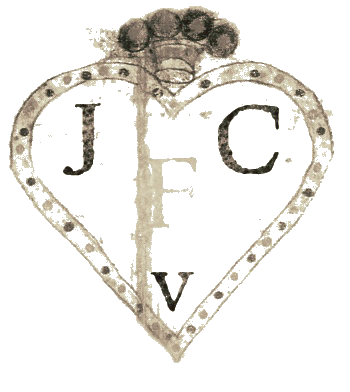The Agony and the
Ecstasy 1965 Carol Reed
Amo te sola I Love You Only (1936)
Vittorio De Sica, later
the director of Bicycle Thieves, stars as John, a young
Neapolitan composer in revolutionary Florence. He falls in love
but is forced to flee to Milan, and success at La Scala. His
memories mean he must return to Tuscany, though, to find his
girl and finally march off to war singing a hymn he composed
himself.
Ad Ovest di Paperino 1982
Descriptions and reviews make this sound
like a surreal version of Amici miei below - odd people
playing tricks on passers by while one of their number seeks her
prince who will, she says, come disguised as a pigeon.
Amici miei 1975
For
Brits I can best sum this up as Last
of the Summer Wine set
in Florence. For the rest of you I'll need to say
it's all about a bunch of unyoung male buddies behaving
like children. Mostly this involves playing practical jokes on
people. There's more sex and swearing here than in L
of the SW and the women are younger and sexier but the concept is the
same, only without the laughs, for me anyway. This film has a
certain reputation but I found it unfunny, dated and unmoving. Philipp Noiret is in it, as is Adolfo Celi in an
uncharacteristicly unvillainous part, at least if you only
know him as a Bond villain and maybe in Who
saw her die?
over on the Venice films page.
Marcello Mastroianni was to star, but thought better of it. The
flashes of Florence are few but very real and very wintery.
There's some action in Piazza SS Annunziata and a funeral leaves
Santo Spirito (both scenes captured right).
This was never released in the UK and it's evidently only
available on DVD in Brazil and Greece. There are two sequels,
providing more of the same.
L'arcidiavolo The
Devil in Love 1966
It's 1478 and Pope Innocent VIII and Lorenzo de 'Medici decide
tp patch up their differences with the marriage of Maddalena,
daughter of Lorenzo and Franceschetto Cybo, the Pope's son. To
prevent this plan the devil sends his emissary Belfagor (Vittorio
Gassman) to kill Franceschetto. Things go pear-shaped when the
arcidiavolo falls in love with Maddalena. Mickey Rooney's in it
too.
Bonus Malus 1993
The unhappy life of an
insurance inspector.
Cari Fottutissimi Amici
1994
It's August 1944 and
following the liberation of Florence Dieci, a former boxing
manager, puts together a team of hungry young men to fight for
food around the countryside. Along the way they pick up an
African- American deserter, a female fascist and a dog. Life
lessons follow.
Caruso Pascoski di Padre
Polacco 1988
The character of the titular
Caruso is played by Francesco Nuti and this is reportedly his
best film, whoever he might be. He plays a psychiatrist whose
marriage is sex-comedy material.
Il Ciclone The
Cyclone 1996
Five flamenco dancers get lost in
the Tuscan countryside and get taken in by a family, bringing a
breath of fresh air to their lives and many plot developments typical of
romantic comedies.
La Congiuntura
1964
Vittorio Gassman plays a Roman
prince who takes Jane (Joan Collins) on a trip to Switzerland.
He expects sex but is getting used and involved in her
smuggling of stolen money. Florence is heavily featured, it is
said. Also features Hilda Barry, a Brit actress who went on to
appear on TV in Hancock, Dixon of Dock Green, Z Cars, Armchair
Theatre, Father Dear Father, The Charlie Drake Show, The
Prisoner, The Forsyte Saga, Adam Adamant Lives, Quatermass and
the Pit and the film Poor Cow. Blimey!
Così come sei
Stay as You Are 1978
Marcello Mastroianni (who is also in the following two Pratolini
Cronaci) is here much older, and playing an architect
deciding whether sex with Nastasha Kinski is a good idea, what
with her maybe being his daughter. A plot summary on the IMDB
calls it a May-September romance - you may call it something
less forgiving. It's also a creepily similar plot to
Obsession below.
Cronaca Familiare
1962
Well that was a bit of a shock - after getting
used to films of Pratolini novels being square and black and
white this one's all widescreen and colour. It's based on what's
said to be the most
autobiographical of Vasco Pratolini's novels, was directed by Valerio
Zurlini, like Le Ragazze di San Frediano and it stars Marcello Mastroianni,
like Cronache di Poveri Amanti. MM
is the older brother, presumably Pratolini himself, who loses
his younger brother to a better-off family when their mother
dies. They are reunited later and their fractured relationship
between the wars, before illness strikes, is the meat of the
film. The actor who plays the doomed younger brother, Jacques
Perrin, went on to have a long and busy career, including many
films with Costa-Gavras and Jaques Demy and Cinema Paradiso.
Not much Florence location filming, but the city gets talked
about a lot, which itself reflects the film's being more a thing
of dialogue than action. It's somewhat undramatic progression
presumably reflects it being a true story. More arty and slow
than the other films mentioned, but still affecting and
cinematically superior. You
can get a DVD from
moviedetective.net.
Cronache
di Poveri Amanti 1954
A
film based on a novel by Pratolini (translated into English as
A Tale of Poor Lovers)
this one also has Marcello Mastroianni in
it (see Cronaca Familiare above). Originally set to be
directed by Luchino Visconti, but he couldn't get the financing.
The plot concerns love's torments and the fight against fascism
in 1925 in a close-knit street in the centre of Florence. (You
can click on the link above to my review of the book for more
plot details). The street itself looks very generic and not very
Florence-y and is almost certainly a set. But there's plenty of
location shooting too, around the Palazzo Vecchio, by the big
churches, and into the more anonymous (and repetitive) suburbs.
(Florence seems to have had a lot of industrial chimneys back
then.) It's a subtle, well-filmed, altogether well-made and
engrossing film, the performances good and the actors
good-looking. You can get a DVD from
moviedetective.net, |
|
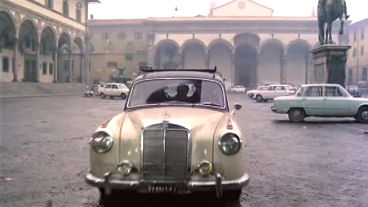
Two screen
caps from Amici miei
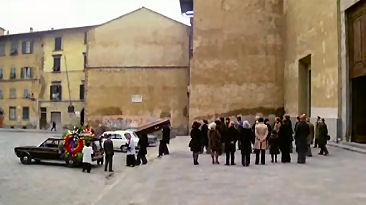
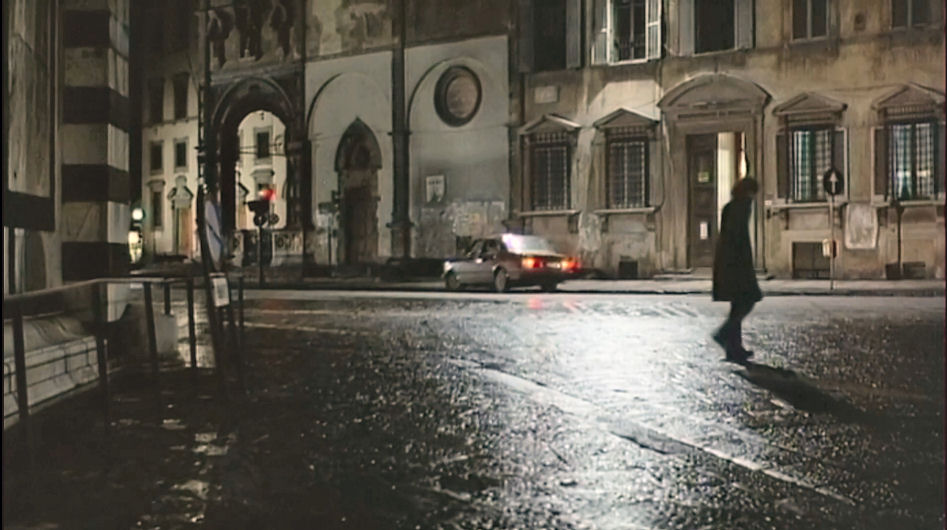
from Cosi come sei
A pre-pedestrianisation scene - the edge of the
Baptistery is left foreground
and the Bigallo just beyond.
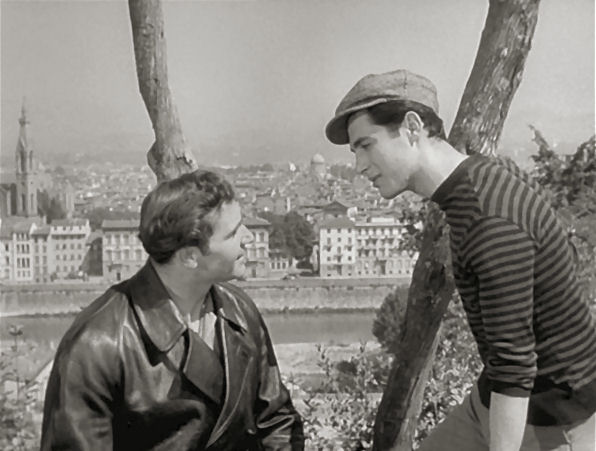
Two from Cronache di Poveri
Amanti
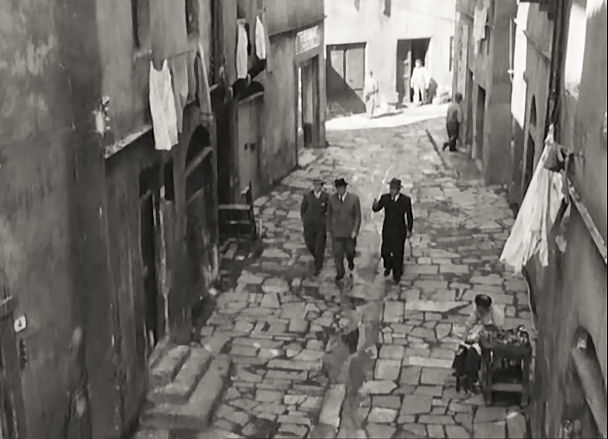
|
|
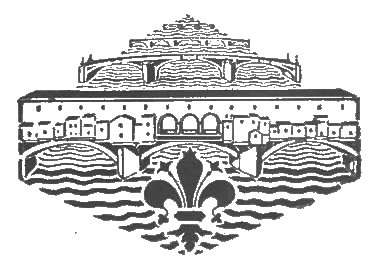 |
|
Da Vinci's Demons |
|
Series 1
Episode 1 - The Hanged Man
Being a high profile
US-made series one wouldn't expect this to be old-fashioned and
historically accurate and full of the truths of Leonardo's life.
But even making these allowances this takes breathtaking
liberties, is utterly of it's time, and emulates recent TV
successes shamelessly. Leonardo is a lustful lad - all
leather-clad pseudo-cockney swagger and man-cleavage, the plot
revolves around mysterious knowledge from the East, contained in
the so-called Book of Leaves, leading to lots of mystical
tosh getting talked in jump-cut drug-induced scenes in
candle-lit ruins, and the Pope and his brutal henchmen will stop
at nothing to protect their secret library and prevent this
dangerous knowledge leaking out. Add some family trouble and
torture, neatly and economically achieved by having Leonardo's
father help give his son a lengthy warning beating, and all the zeitgeisty buttons are being pushed. Hard. Oh and there's also
lots of sex and bosoms and bottoms, and even a couple of
willies. But there's no denying the attraction of the shiny toys
and post-Game of Thrones production design, and there are
sundry bits of nice business for us more clued-up types.
Leonardo designs a mechanical Colombina to fly from the
Duomo into the fireworks on Easter Sunday not on a wire but
flying free and stuntfully. And the façade of the Duomo is
unfinished and taking on its earlier appearance (see below right) as it was in Leonardo's time. But to
return to the downside: people do call him Da Vinci, he's not
gay, he needs his opium, and he doesn't remember his mother, who
may have been a slave from the East. (Although he is said to
have had mother issues due to his having not known her beyond
the first five years of his life.) Also the Medici keep
getting referred to as the Medicis. So, a combination of
cringe-making fashionable clichés and inauthenticity with smart
bits of business and a glowing computer-generated period
Florence. Well, I'm hooked.
Episode 2 - The Serpent
Less flashy and less spectacular, faked-Florence-wise, but
providing some flavoursome plot-thickening. An attention holder
rather than grabber methinks. In recent promotional interviews
Tom Riley, the actor who plays Leonardo, has promised that
episodes 3 and 4 will deal with our hero's sexuality and the
fact of its not being just hetero. We'll see how this is
played.
Episode 3 - The
Prisoner
Saw more searching
for the spy in the Medici midst and further despicable papal
plotting, with a mysterious and gory outbreak of something nasty in a
convent creating zombie attack nuns. I exaggerate only slightly.
There was also a scene set in a version of the Medici Palace's
Chapel of the Magi, but with imitations of the Gozzoli frescoes
featuring the faces of the series' characters. Also a
scene-setting piece of CGI (see below right)
featuring a view of Florence looking like it would've looked in
the 15th century, removing the later sprawl and putting the wall
and its towers back. But they left the Library (left of centre,
with sunlit towers) which opened in 1935.
Episode 4 - The Magician
Contained little CGI trickery and faked Florence fun but much
more gore and brutality. Riario and Rome messily murder almost
all of the Medici alum miners and then threaten to lay siege to
Florence, so it falls to Leonardo to protect the city by means
of superior technology or wily stratagems. The promised
investigation of our hero's non-straight sexuality turns out to
amount to merely the well-documented accusation of sodomy which
sees him arrested at the end of this episode. Such anonymous
accusations being a not-uncommon way of settling scores in
Florence at this time. He had previously reacquainted himself
with Lorenzo's mistress's intimate parts and got his mental
knickers all twisted about the Medici connection to the mystical
Sons of Mithras/Book of Leaves business, which looks set to lead
us to a new continent not entirely unlike America. Slip-ups this
week included the accusations against Leonardo being formally
and loudly proclaimed as grievious and the name of the
architect of the Duomo being pronounced to rhyme with fleshy
rather than pesky.
Episode 5 – The Tower
Leonardo spends most of this episode in prison, facing
the accusation of sodomy, which incarceration makes his Hoxton
quiff go even quiffier. Many courtroom scenes, too, and scenes
in the oddly gothic Medici Palace, as Lorenzo tries to win the
account of Ferdinand and Isabella of Spain for the family bank.
The matter of Leonardo's gayness is not exactly fearlessly
confronted, but neither is it cravenly sidestepped - he snogs a
man, but in the next scene is sexily bathing with the gorgeous
Lucrezia Donati, Lorenzo's mistress. His genius this week makes
for bomb-bearing bats (the bombs being made from bat crap) and
the invention of photography (and the Batman bat signal) in the service of the exposure of an enemy's indulgence in
bestiality. I can't find either of these in the reference books.
The tone of this series remains uncertain, but it's still
enjoyable bunk.
Episode 6 - The Devil
This episode has some scene-setting mystical bollocks to begin with,
followed by plenty of penises, including the Pope's, and then
Leonardo and chums are off to visit Dracula. Paul Rhys puts in a
fine and bonkers performance as said Vlad, with a wacky accent
variously combining Transylvania and Wales. Another one low on
CGI Florence but with much gore and brutality. Still enjoyable
and dark bunk, with some landscapes a little suggestive of the
backgrounds of some of Leonardo's paintings, don't you know, particularly the
Virgin of the Rocks. Two more episodes to go.
Episode 7 - The Hierophant
This episode begins with Leonardo and his gang spying on
Riario in a very un-Italian-looking (Welsh?) graveyard. Our hero
needs to get into the Vatican to find the other half of his
magic key, you see, and somewhat spectacular and very
plot-progressing it all turns out. In Florence the discovery of
the identity of the Papal spy progresses, as does the Pazzi
Conspiracy, which looks like making the series finale, although
it makes some very inauthentic progress at the end of this
episode, which needs to do too much story-progression to allow
for much CGI jiggery-pokery, or location fun. The Pazzi
Conspiracy is hatched around a large table, Mafia style, of
course, as all conspiracies have to be. This being an American
series, the main plot strands are driven by love for a
father and the need to find a mother, but, sneaking just beyond
the predictable, a brace of surprises do keep us gripped for...
Episode 8 - The
Lovers
The series finale begins
with some more mystical stuff inside another ruined gothic abbey full
of candles, with Leonardo presented as The Chosen One, just like
Buffy, and seemingly at last getting a bit fed up himself with
all the rubbish the foreign bloke in the eye-makeup spouts. But he
remains convinced, as we gallop to a breathless conclusion,
which ends on a cliff-hanger. The Pazzi Conspiracy propels the
episode as strands join and twist and the outcome is roughly
historically true, but the Pazzi poisoning the Medici's
Eucharistic wafers is a wild invention. The outcome is brought
about by blades, which does ring true, but in this case it's an
OTT swashbuckling finale where Leonardo saves the day, and
Lorenzo. The façade of the Duomo is still not finished,
for the episode's big finish, so we get some more CGI Florence
prettiness. Oh, and Lucrezia
Donati's dad turns out to not be Gandalf after all. And the
promises that the series will not shy away from showing Leonardo's
gayness have proven pretty hollow.
It seems that the process by which a gay
character is made out to be, against all accepted wisdom, a
macho womanising stud is called straight-washing.
 |
|
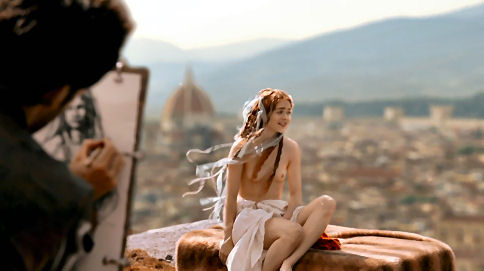
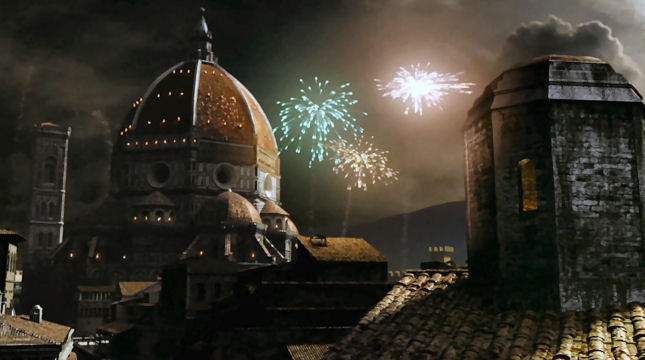
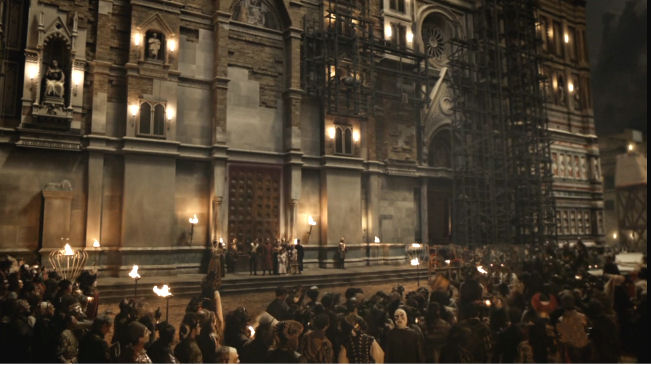
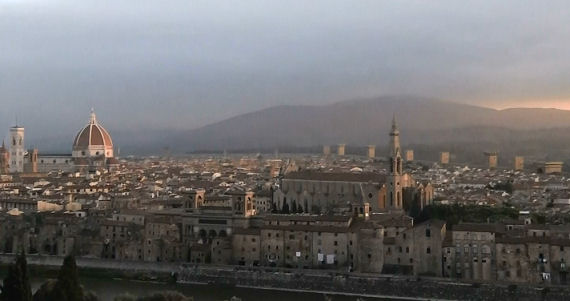
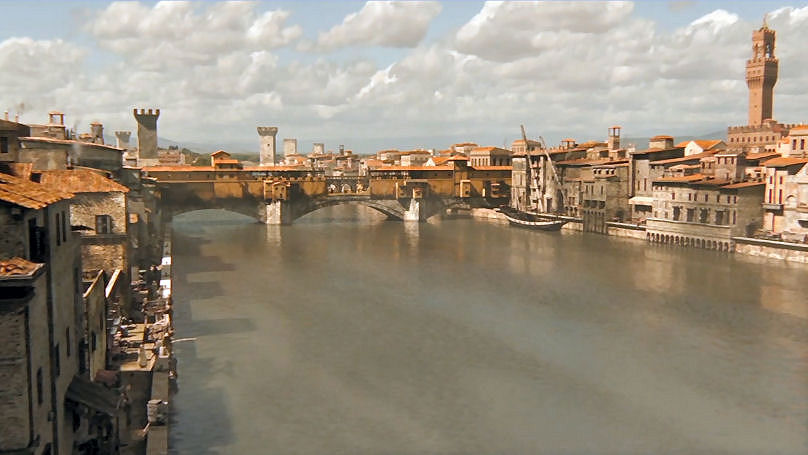
Series
2
Episode 1 -
The Blood of Man
The end of Series 1 of DVD left much blood still dripping and
being let. In the aftermath of the Pazzi attack Leonardo escapes
through the sewers with Lorenzo and saves him by inventing blood
transfusions. Lots of action, lots of mystical mumbo-jumbo,
flashbacks, flashforwards, dream sequences, throat-cuttings and
much use of the f word. Pretty much the old recipe, then, but
directed by Charles Sturridge (of Brideshead Revisited TV
series fame) and all breathlessly exciting stuff.
Episode 2 - The Blood of Brothers
This episode has less expensive action sequences and CGI vistas and
a bit more plot. Lorenzo wins back the love of Florence, with the help
of Leonardo and some copper sound-reflecting dishes, so that
Lorenzo can rouse the rabble from the CGI campanile of the
church of San Lorenzo. The real
campanile, built 300 years later, looks very different. Following a
good deal of score-settling Leonardo is set to take a ship to
follow Riaro (who has taken his map and his mate) and go look
for the Book of Leaves, the ancient wisdom which it contains
being guaranteed to answer all questions and solve everyone's problems.
So, who's he going to call on for help? Amerigo Vespucci of course.
This is where the story splits and the
plots get even more campy and sanity-stretching:
Leonardo heads for South America for some Inca action, Lorenzo
gets mixed up in Italian political shenanigans and imprisonment
and I decide that life is too short. |
|
|
Dante Nella Vita e Nei Tempi
Suoi 1922
A racy-looking film of Dante's life
after the death of Beatrice, involving Guelphs, Ghibellines,
political shenanigans, nun kidnapping, and the poet's son
finding the last pages of the Paradiso in Ravenna.
Escapade in Florence 1962
Two episodes of an
American TV series Walt Disney's Wonderful World of Color
later edited into one film. It stars Tommy Kirk and Annette Funicello as a pair of teenagers in Florence who get caught up
in a plot involving art forgery. Long out of print, and only
ever released on VHS, but all filmed on location, it seems.
Eutanasia di Un Amore 1978
Based on a novel with the
same name by George Saviane, this is the story of the rocky
relationship of a professor with his former student, played by
Ornella Muti. Reportedly a film full of walking and talking.
|
|
Die Flucht in die Nacht
(1926)
A German film based on a Pirandello story,
starring Conrad Weidt, known to English-speaking audiences as
Major Strasser in Casablanca, he also starred in The
Cabinet of Dr. Caligari. Here he plays Henry IV of Germany
who falls from his horse and loses his memory. For many years
this was thought, wrongly, to be the first film shot in
Florence.
Forbidden Music Musica
proibita 1942
Tito Gobbi stars as an ageing and lonely
opera singer remembering his student days in Florence and the
bumpy road of his long-ago love. Not a film I feel drawn to
watch all through, not being an opera buff and the
tone seeming somewhat fluffy on a quick scan through for
location interest. All I could find beyond studio filming was a
brief walk-and-talk in a garden overlooking the distant Duomo,
etc.
From Scratch 2022
Looking pretty much your
standard fish-in-pretty-new-water romance, starring the
ubiquitous Zoë Saldana, this is a Netflix series. I did a quick
scan through the first episode. It included the wide-eyed
arrival, being met by the smoking Italian in the miniskirt in
the red Fiat, falling for a handsome chef, bringing over the
parents, who disapprove a lot, and having big snogs in the rain
pre-sex. Lots of pretty Florence filming though, at least in the
first episode. Later they return to Los Angeles.
|
The Girls of San Frediano
Le Ragazze di
San Frediano 1954
A film based on another novel by Pratolini and also directed by Valerio
Zurlini, like Cronaca Familiare above. It concerns Bob, a
handsome mechanic who juggles the affections of six women,
making promises he can't keep to all of them. He's called Bob
not to make us smirk and think of Rowan Atkinson, but because of
Robert Taylor, who all the boys were trying to be at this time,
it seems. This is broadly a comedy, with some teeth, but not
many, and they're not that sharp. It may be the passing of time,
or the Italian sensibility, but Bob doesn't ever get the
(metaphorical or real) kick in the testicles that he so richly
deserves, and which he does get, it seems, in the novel. Looked at with allowances for its age, though,
it's an enjoyable slice of fifties Florence. Not much location
filming, but what there is is authentically non-tourist. A
panoramic sweep at the end gives us the North end of the Ponte Vecchio still a bomb site and some temporary bridges
(see below) built after the Nazis blew up the old
ones. The story was also made into a TV series
in 2007.
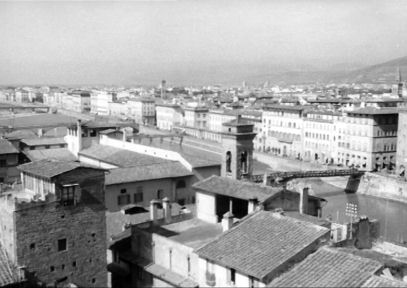
|
|
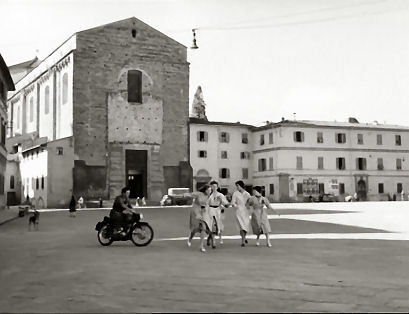
Three from
The Girls of San Frediano
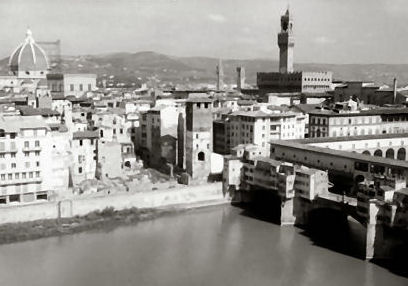
|
Giuliano de' Medici
The Conspiracy of the Crazy 1941
A film
about the Pazzi Conspiracy, which was its original title, but
Mussolini saw it and feared that it might incite rebellion. He
had it withdrawn from distribution, purged of political
references, and given the title Giuliano de 'Medici.
Although some reports claim that the name change was from The
Conspiracy of the Crazy to The Pazzi Conspiracy.
Hannibal
2001
To concentrate on
the presence of Florence in this film in the light of all the
other famous factors may seem a little odd, but I
probably wouldn't have bought the DVD of this, what with the
mixed reviews and all, if it wasn't for the Florence factor, and
that's what this page is all about, after all. And Florence does
look handsome, it must be said, as does Julianne Moore. She's a
mighty fine actress, but played some pretty unlovable characters
around this time, in the likes of The
Hudsucker Proxy
and Cookie's
Fortune.
She's not at all unlovable in this one. What is unlovable is the
book's famous nasty ending, which is not so nasty as filmed here, just
laughable. The rest of it chugs along quite nicely in a way
which keeps you quite gripped but leaves no lasting impression.
Effective, with good locations - the library where Hannibal works
is, in fact, the famous Foundling Hospital - but this is far from a great
film.
Hannibal TV series (2013– )
The TV series derived from
the film, made by Bryan Fuller, a man closely linked with series
we've liked, like Heroes, Wonderfalls and Pushing
Daisies. But it was only with 2015's Series 3 moving the
action to Florence that I was tempted by Hannibal, and the fact that Gillian
Anderson and Eddie Izzard are in it. Anderson plays a
psychiatrist and Izzard a willing victim getting gradually
relieved of his limbs and served them at the dining table, in
black and white, and so presumably flashback - jumping in after
two seasons can be confusing. It's all very stylised, but not
half as stylish as it thinks it is. Similarly it's
self-conscious cleverness comes across as show-offy
clever-cleverness rather than authentic wit. It's all murk and
threat and slow-motion drops of blood and water, gratuitous
dream sequences and disturbing discordant music. The
concentration on Dante scholarship is very Dan Brown too, and
the whole eating people thing is just so...unvegetarian. Not for
me.
The Killer is Still Among Us (L'assassino
è ancora tra noi) 1986
A giallo that's reported to be
nasty even by the standards of the genre. It's another
telling of the Monster of Florence story, but this time with a
young female criminology student on the trail of the serial
murderer and mutilator. Sounds pretty gruesome, and not in a
good way.
I Laureati (The Graduates)
1995
Four young men fritter their lives away in
Florence. The first film directed by Leonardo Pieraccioni.
No, me neither.
Inferno
2016
I think that it goes without saying that
this film is easier to watch than Dan Brown's original book is
to read, but is hardly an award winner. The beginning is all disturbing jump-cuts, discordant
noises and gory hallucinations, but things soon settle into the
usual blizzard of puzzles, double-crosses, frowny bits and impending global
apocalypse. Plenty of Florence locations, including a dash to
and through the Boboli Gardens because 'the Palazzo Vecchio is
near the Boboli Gardens' - well it is if you know the secret
entrance into the Vasari Corridor in the Boboli, and it's not
locked. There's a brief visit to Venice too, before the big
finale in Istanbul. Aside from Tom Hanks as our hero this stars
Felicity Jones (from the new Star Wars film Rogue One) as
his sidekick and Sidse Babett Knudsen (who impressed in the
recent first Westworld season and who was in Borgen)
as his old flame from the World Health Organisation. An
efficient job of storytelling, then, and not a little scary and
violent. The plot twist at the end of the book doesn't make it
onto the screen, though.
Leo da Vinci: Mission Mona Lisa
2018
Young Leo is a 'tween boy inventor of complex
wooden contraptions who, when his friend Lisa is in need, goes to
Florence to make a fortune and ends up mixed up with pirates.
The characters in this one have that look that's identical to
all computer-animated young humans post-Frozen, and it
seems to have nothing unusual or special about it. Some younger
children join the band, there's a villain with a pigeon with an
eye-patch, Florence looks like it's built of plastic play bricks and,
well, I'll admit to only sampling, and
not having the stomach for watching it all.
Light in the
Piazza 1962
The film of
the novella by Elisabeth
Spencer, which tells of an American woman visiting Florence
with her daughter who is twenty-six but, following a childhood
accident, is much younger mentally. A touching and real
relationship develops between the daughter and a charming local,
much to the mother's delight and disquiet. Olivia de Havilland
plays the mother, Yvette Mimieux the girl, and George Hamilton
the suitor. The father of the local suitor is
played by Rossano Brazzi, of course, who can always be relied
upon to be grey-templed and suave whilst talking seductively of
love. The director was Guy Green,
the famed cinematographer who won an Academy Award for his
memorable work on the David Lean Great Expectations. The
film doesn't shy away from the central theme of the daughter's
mental disability and in fact by visualising it - with girlish
skipping and giggling and cuddly toys - it all becomes more
evident. An odd and original story makes for a somewhat odd and impressive film,
with some sound acting and sharp dialogue. The Florentine locations are varied and keep pretty much to those named in the book.
Streets around San Frediano and Santa Maria del Carmine are
unusually well used. But oddly the Piazza della Signoria, the
scene of the
symbolic cannon incident mentioned in the title, becomes a park.
Light in the Piazza, the book and
film, have also now been made into a musical.
Lorenzino de'
Medici The Magnificent Rogue 1935 Magnificent Rogue 1935
It's the early 16th Century and Duke
Alessandro de' Medici is lording it over Florence. His cousin Lorenzino is in love with Bianca Strozzi but suspects a
kidnapping plot and plans to assassinate the duke. Lorenzino
later has to flee to Venice, pursued by Cosimo de 'Medici's
assassins. This one did get a US release, but I've never seen
it. Bronzino and Benvenuto Cellini appear in it too.
The
Marshal
1993
This
one-off was on UK television many years back, with Alfred Molina
making a fine stab at Ms Nabb's Marshal, with Gemma Craven as his
wife, and Jude Law was in it too. Filmed on the Marshal's
fictional patch around the Oltrano district, it is said that the
author hated it and blocked any repeat showings. I watched it and
enjoyed it back then but foolishly failed to keep my old VHS recording.
Medici: Masters of Florence
2016
This is an Italian-made TV series, available on
Netflix. It's got lots of Italians in it, along with some faces
from Game of Thrones and
Dustin Hoffman. I'll give it a watch and report soon. Meantime
the screen grab (below right) shows the Duomo awaiting
its dome, with the walls of Florence behind, towers spaced along
them, enclosing lots of fields still. Authentic!
Metello 1970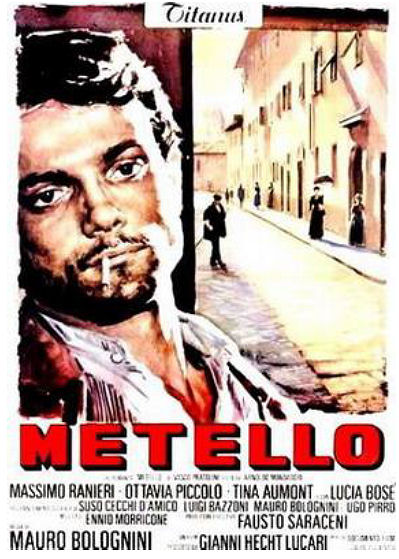
If I tell you that this one is largely
concerned with labour struggles and a long-running a strike in
the early 20th Century you probably won't need telling that it's
based on a novel by Vasco Pratolini. It won the David di
Donatello for Best Picture in 1970 and Ottavia Piccolo got the
award for Best Actress at Cannes.
The
Monster of Florence 1986
An Italian filming of the
story of the famous (and somewhat over-exposed) serial killer,
this one does not come any higher than politely recommended, and
then only in comparison to the same year's The Killer Is
Still Among Us mentioned above.
There's been talk of a Hollywood version of journalists Douglas
Preston and Mario Spezi's investigations for a while, with
George Clooney being reported to have signed up to play Preston in 2011,
but there has no news since then. Maybe the serial killer thing has run
its course.
Il Mostro di
Firenze The Monster of Florence 2009
An Italian TV Mini-Series
of 6 episodes. It has one of those trendy and jittery hand-held
intro sequences that Homeland has pretty much nailed. I
got hold of a copy of episode 1 with no subtitles and scanned
through for location interest. It looks as if the glamorous
female investigating detective is having to cope with the macho
preconceptions of her colleagues and there seems to be that
fashionable focus on the lives of victims and their families.
Some street scenes look very Italian, if not very Florentine,
and there's some blurry Duomo views through office windows. Also
flashes of random Florentine building and statuary details to
suggest that the following scenes are in local interiors, I
suppose, although they usually just precede another visit to the
mortuary.
|
|
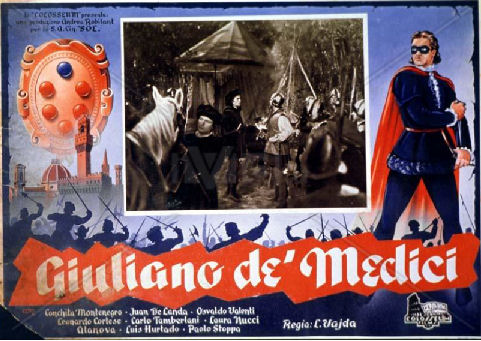
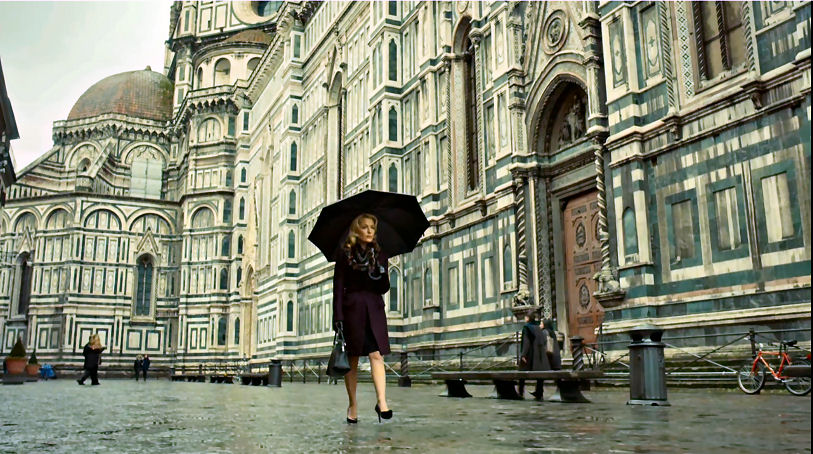
Hannibal
the TV series
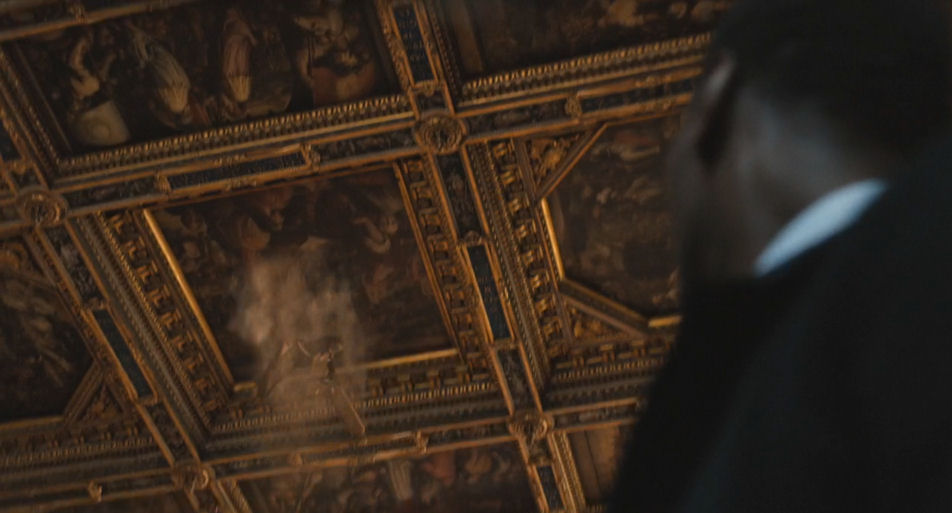
from Inferno
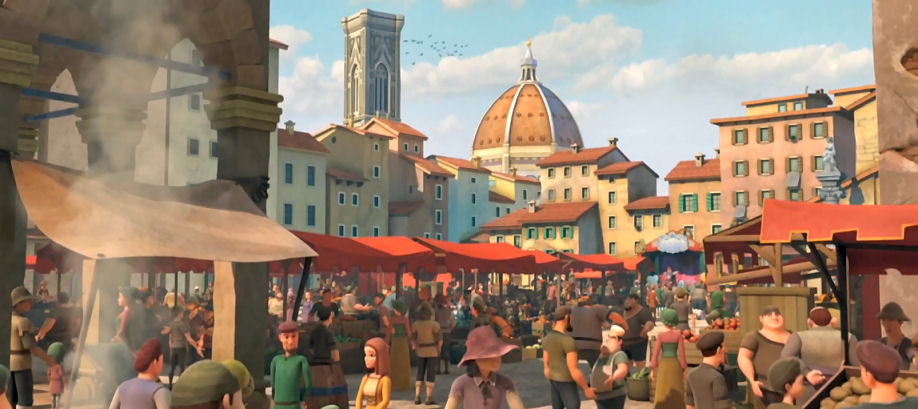
from Leo da Vinci: Mission Mona Lisa
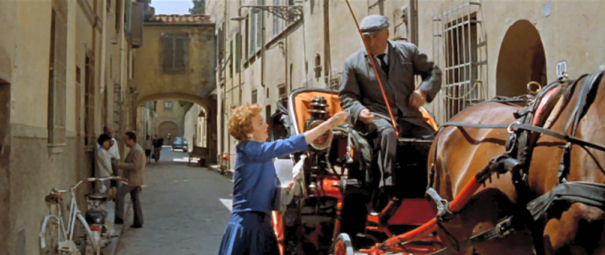
Three from Light in the Piazza
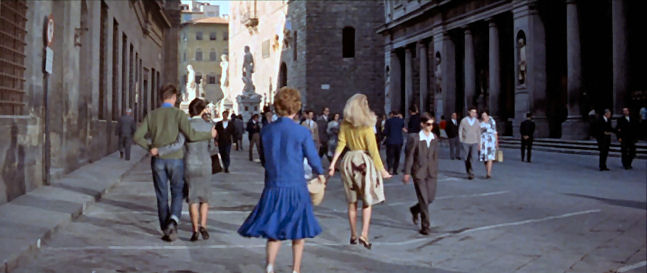
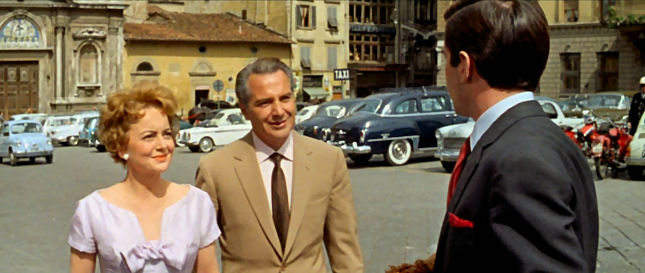
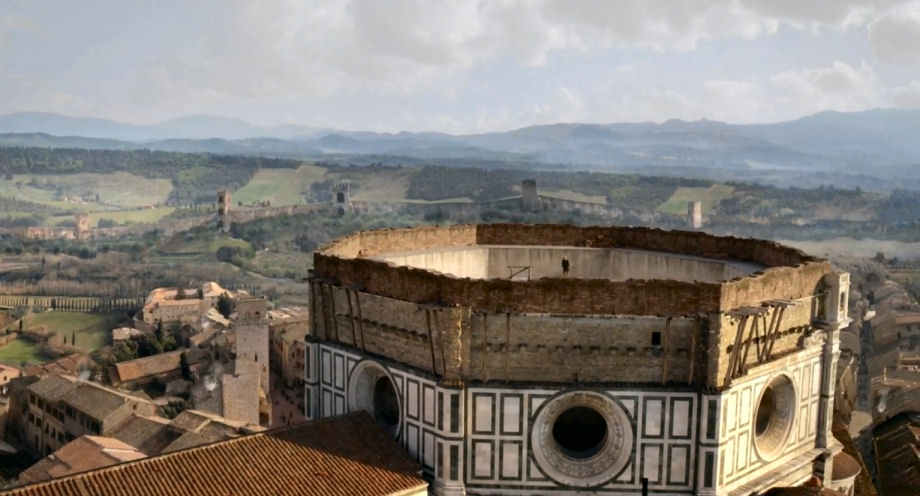
from Medici: Masters of Florence |
|
Natale al Campo
119 1947
Spending Christmas in the
United States as prisoners of war in camp 119 Italian inmates
reminisce about their home towns. A soldier from Florence tells
his story of love during wartime and Venetian tells a tale of a
lovelorn gondolier.
Obsession
1976
The
director is Brian De Palma and the lead actor is Cliff Robertson,
and I'll admit that I'm no fan of either of them. Here De Palma
makes a very poor fist of making an Alfred Hitchcock film and
Robertson is no Cary Grant. Stoney-faced Cliff plays a man
whose wife and daughter are killed in a botched kidnap payoff. He
builds a tomb looking like the church of San Miniato in Florence,
where he first met his wife, and after a decade and a half of obsessive
mourning he revisits the city and the church and finds there a
young woman who is the dead spit of, you guessed it, his wife,
played by Genevieve Bujold. I'm betting that, bearing in mind the
long gap of years, you've guessed who she is, but Robertson
doesn't, and we're not supposed to. It's all credulity-stretching
tosh. The photography has its moments (thanks to Vilmos
Zsigmond), Florence is a handsome backdrop for about half an
hour, Bernard Herrmann makes stormy music like he did for
Hitchcock, and Ms Bujold can act. But as a Vertigo-influenced
piece of filmic art it's laughable. It's also shot through
Vaseline-smeared lenses, for some reason. As
far as location-spotting goes...upon entering San Miniato our
hero is miraculously transported to another church. In the documentary
amongst the extras on the Dutch DVD De Palma tells us that the
Vatican would not allow filming there after a previous film crew given
permission had made a porn film. So he was forced to film the
interior in a church in what sounds like 'San Gemignato', which I
presume means San Gimignano. The Piazza SS Annunziata makes a
brief appearance, of course, and Ms Bujold's house doorway is in
a picturesque buttressed-over street that I didn't know in
Florence but found on a subsequent trip.
This film is now available on Blu-Ray
from Arrow Films.
Paisa
1946
A
grimly realistic portmanteau war film directed by Roberto
Rossellini, with episode four a tale of the resistance in
occupied Florence adapted from a Pratolini story. The six episodes
progress with the allies progress up from Sicily into northern Italy.
The
Plague in Florence Die Pest in Florenz 1919
Written by Fritz Lang and directed by
Otto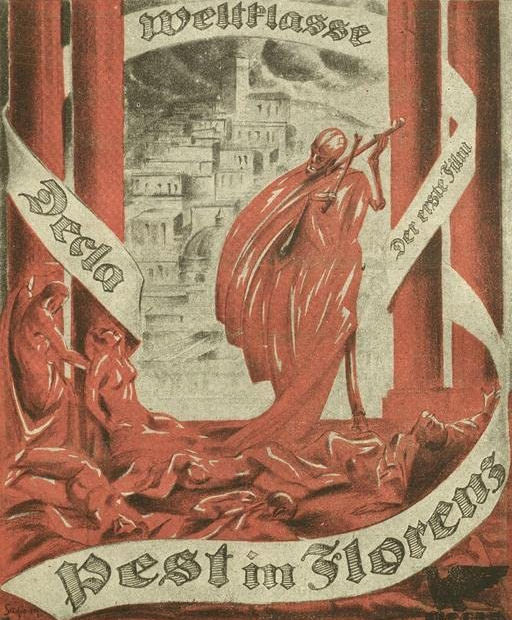 Rippert, adapted from 'The Masque of the Red Death' by Edgar
Allan Poe story. The IMDB says that it was only ever released in
Finland. Tantalising, especially for this keen Lang fan. The
plot sees Julia, a wealthy courtesan, arrive in Florence and a
cardinal fearing that her allure could tempt people away from
the church, so he orders inquiries into the strength of her
faith. Lorenzo, son of Cesare, the city's ruler, leads a mob to
storm the palace where Julia is about to be tortured. To rescue
her Lorenzo kills his father, sensual excess infests the city and Medardus, a Savonarola-like hermit, falls prey to Julia's beauty
and is driven to sacrilegious acts. Things go from bad to worse,
debauchery wise, until a ragged female personifying the Plague
infects the city and plays her violin as the corpses mount
up. Rippert, adapted from 'The Masque of the Red Death' by Edgar
Allan Poe story. The IMDB says that it was only ever released in
Finland. Tantalising, especially for this keen Lang fan. The
plot sees Julia, a wealthy courtesan, arrive in Florence and a
cardinal fearing that her allure could tempt people away from
the church, so he orders inquiries into the strength of her
faith. Lorenzo, son of Cesare, the city's ruler, leads a mob to
storm the palace where Julia is about to be tortured. To rescue
her Lorenzo kills his father, sensual excess infests the city and Medardus, a Savonarola-like hermit, falls prey to Julia's beauty
and is driven to sacrilegious acts. Things go from bad to worse,
debauchery wise, until a ragged female personifying the Plague
infects the city and plays her violin as the corpses mount
up.
Pontormo 2004
An episode in the (later) life of
the famed mannerist painter, here played by Joe Mantegna, aka Fat Tony
in The Simpsons. It was only ever released in Italy, it
seems, and then shown on TV in Hungary a few years later.
Porta Un Bacione a
Firenze 1956
The title translates as Bring a Big Kiss to
Florence.
Simonetta, the daughter of a
Florentine living in New York, takes herself to Florence
to convalesce from an eye infection. She stays with the Count
Pineschi, an old friend of her father, and a love triangle
ensues involving a sculptor and a policeman's daughter. The title
is that of a famous song sung by Odoardo Spadaro, known as the
Italian Maurice Chevalier, who makes a brief appearance in the
film.
The Portrait of a Lady 1996
Nicole
Kidman plays another of Henry James's American women of means
bouncing around Europe and turning down offers of marriage, until
she meets the wrong man, played by John Malkovich. It's all very
intense and modern, and the scenes in Florence amount to two
brief views - a carriage passes the Duomo and someone walks
through the Piazza SS Annunziata carpeted in cabbage leaves.
Ricomincio da
tre (I'm Starting from Three) 1981
A young Neapolitan called Gaetano decides to leave home and goes to stay with his aunt in
Florence. Written by, directed by and starring Massimo Troisi.
|
|
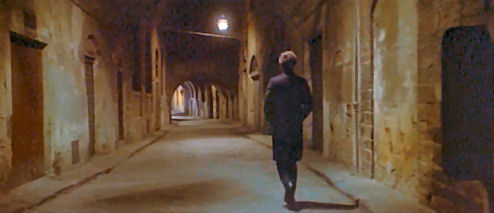
Two
from Obsession
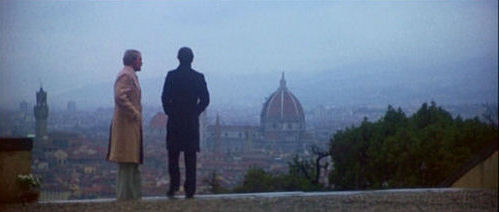
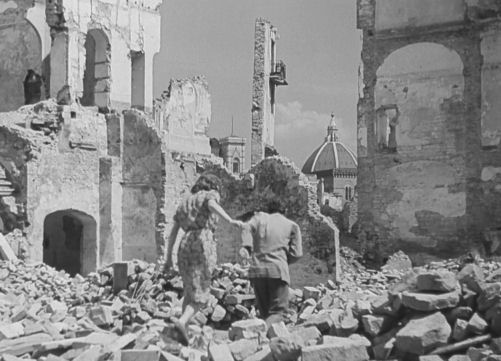
Two from Paisa
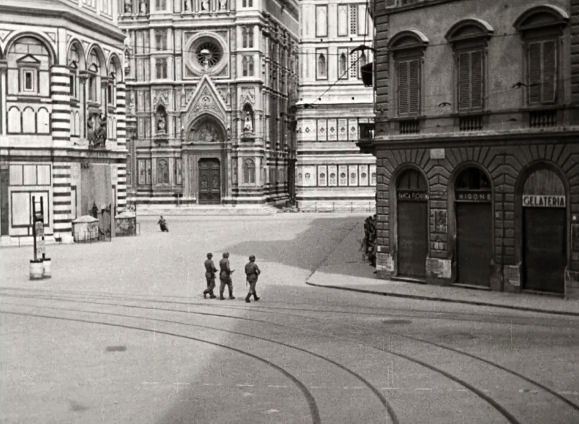

From The
Portrait of a Lady
|

![]()
 Magnificent Rogue 1935
Magnificent Rogue 1935
